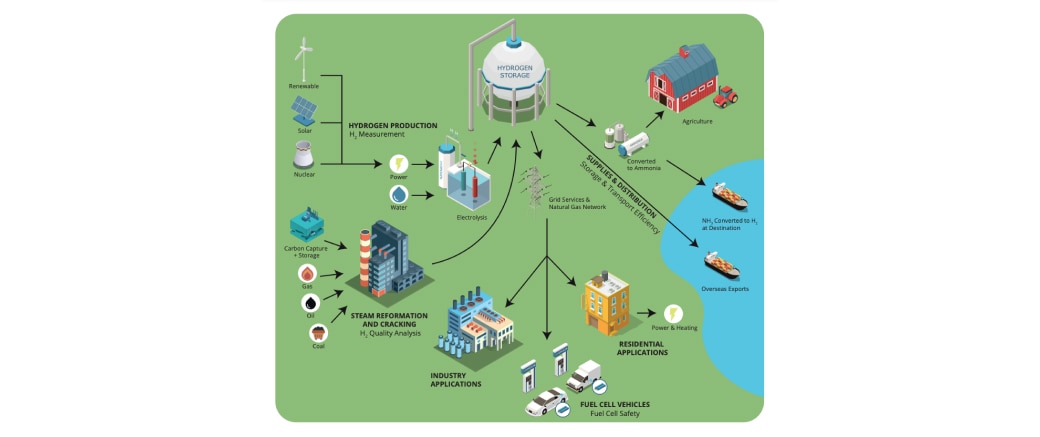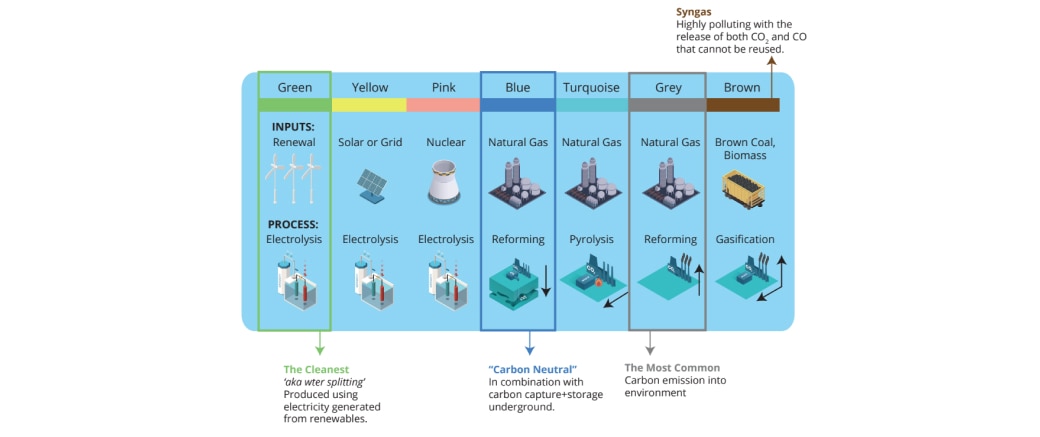Shimadzu's Solutions To Support Carbon Neutrality

As economic growth and development progress globally, the demand for energy continues to expand exponentially. However, because fossil fuels are finite, many countries are part of a global movement to produce more alternative or renewable fuels. Not to mention, they are also used to reduce harmful gas emissions. From bioethanol to biodiesel, these fuels are becoming more ubiquitous at the gas stations and airport fuel facilities of the world due to governmental mandates.
Currently, bioenergy stands out as the largest source of renewable energy worldwide, with biofuels being the only renewable energy source that can be directly used in the transport sector. This unique quality can allow biofuels to leapfrog traditional barriers, enter the market quickly, and drive accelerated change towards clean energy. As such, biofuels can potentially decarbonize hard-to-electrify sectors, such as aviation, heavy-duty transport, and shipping.
With increasing anticipation for technologies related to renewable energies for achieving a sustainable society, Shimadzu’s analytical and measuring instruments play a vital role in contributing to the research and development of power generated from renewable energy.
Read on below to learn more or download the 99-page compendium book to discover Shimadzu’s solutions to biofuels and biomass.
Shimadzu's Solutions To Biofuels and Biomass
As the global concern for climate change continues to grow, the need to mitigate CO2 emissions has become an urgent priority. To achieve this goal, there has been a concerted effort to seek clean and sustainable energy sources, and among the viable options, the use of biofuels and biomass-based products derived from plants and algae has stood out as promising solutions.
Biomass is a renewable hydrocarbon resource derived from animals and plants, and examples include wasted wood, surplus food, and cultivable microalgae. Notably, algal biomass has gained attention as a new renewable energy alternative to oil resources, particularly because algae can produce oil without competing with food production. Moreover, the algal production efficiency per unit area is higher than some of the biofuels, such as corn and sugarcane.
Analytical Techniques For Biomass Analysis Include:
- Total Organic Carbon Analysis
- Liquid Chromatography
- Gas Chromatograph-Mass Spectrometry
- FTIR Spectroscopy
- UV-Vis-NIR Spectroscopy
- Thermal Analysis
For biofuels, it come in three primary forms: solid, liquid, and gaseous (also known as biogas). Typically, liquid biofuels are used as transportation fuels, while biogas are mainly used for electricity and heat production. In the first generation of biofuels, production relied on edible energy crops, including sugar-based, starch-based, or oil-based varieties. Examples of these crops included sugarcane, corn, wheat, rapeseed, and sunflower, among many others. However, due to the serious concerns about food security and competition for arable land to grow energy crops, secondgeneration biofuels were then developed. These are derived from lignocellulosic crops, such as wood and its byproducts. More recently, third-generation biofuels, which rely on the use of algal biomass as a source, have also emerged.
Analytical Techniques For Biofuels Analysis Include:
- Gas Chromatography
- Liquid Chromatography
- Gas Chromatograph-Mass Spectrometry
- FTIR Spectroscopy
- Energy Dispersive X-ray Fluorescence Spectroscopy
- Inductively Coupled Plasma Emission Spectroscopy
For more, download the compendium book to discover comprehensive workflow solutions.
Artificial Photosynthesis
Artificial photosynthesis is a technique to harvest solar energy and stored it chemically. During the process, abundant materials such as CO2 and H2O are captured and converted into renewable energy sources.
The process of artificial photosynthesis requires the use of photocatalyst to enable the redox half-reactions to proceed efficiently. Specifically, it can take place in two forms: (1) water-splitting reaction (2) photochemical reduction of CO2. In both cases, the reaction products such as H2 and methanol can be directed into fuel-cell setup to generate clean energy.
With the increasing concentration of atmospheric CO2 and worsening global warming, artificial photosynthesis is critical to establish the envisioned future of closed carbon cycle – where excess CO2 generated from man-made activities would be captured and re-used as solar fuels.
Types Of Artificial Photosynthesis Research
The design of the artificial photosynthesis device can be inherently complex and challenging. Currently, there are 4 strategies to mimic the natural photochemical system:
Semiconductor Catalyst Systems
Inorganic and organic semiconductors can be used as light-harnessing materials in photovoltaic devices to convert solar energy into clean fuels. Recent research has probed into the use of semiconductor nanostructures to improve reaction efficiency.
Supramolecular Systems
Supramolecular chemistry is characterized by using non-covalent interactions to establish complex macromolecules. These systems typically utilize metal complexes such as ruthenium (Ru) and rhenium (Re) as photocatalysts.
Hybrid Systems
Hybrid systems combines semiconductor and supramolecular materials to capitalise on their advantages and hence create a synergistic effect in enhancing the overall efficiency of the photocatalytic reactions.
Biological Systems
Light-sensitive microorganisms such as microalgae and cyanobacteria can be cultured and used as biological converters to produce renewable biofuels from CO2 and solar energy.
Role Of Analytical Instruments For Performance Evaluation
Analytical instruments such as GC, HPLC and absorption photometry are typically used for measuring the reaction products in artificial photosynthesis to evaluate its solar-to-chemical conversion efficiency or the catalytic activity performance of the photocatalysts. This can allow for further optimisation to drive artificial photosynthesis as the next-generation renewable energy.
Shimadzu’s Solutions to Hydrogen Supply Chain
In light of urgent environmental concerns, a transition to Hydrogen Economy is essential to pay way towards a carbon-free society and build a more sustainable future. In the Hydrogen Economy, hydrogen is used as a low-carbon energy source to replace conventional fuel sources like gasoline or natural gas. Hydrogen is perceived as an attractive solution because it has the potential to provide clean energy since its only by-product is water. As the global countries works toward decarbonization over the coming decades, hydrogen will play an increasingly important role in a successful energy transition and in meeting the net-zero carbon emission goals.

Ideally, green hydrogen produced entirely from renewable energy will serve as a clean and sustainable fuel but other colours of hydrogen, such as blue hydrogen, will also play a key role by facilitating the energy transition toward the Hydrogen Economy. The different colours of hydrogen and production sources are illustrated as below.

Shimadzu provides practical solutions for building a feasible hydrogen supply chain, from hydrogen production to transportation and storage. This compendium book offers a variety of application notes to showcase how Shimadzu’s instruments can help harness the potential of hydrogen as the fuel of the future.
With Our Products and Technologies, Shimadzu Contributes to Solving Problems in a Diverse Range of Fields
We contribute to technological development and quality control in fields such as hydrogen fuels, biofuels, wind power generation, and other renewable energies, as well as automobiles and storage batteries, which are all indispensable for achieving carbon neutrality.
In addition, we are actively adopting renewable energy in our business activities, aiming to reduce CO2 emissions. For example, Shimadzu has pledged to use electric power from 100% renewable sources in the Shimadzu Group’s business activities in Japan and abroad by 2050. Solar panels have been installed at the Head Office/Sanjo Works and Murasakino Works in Kyoto, as well as at Shimane Shimadzu and other Japanese Group companies, and in Malaysia, the Philippines, and other overseas Group companies. The power generated is then used in-house. Group companies in the UK and Germany have switched to contracts for power from 100% renewable energy. Beginning in FY 2021, Shimadzu is gradually introducing 100% renewable energy at Shimadzu Group plants, research centers, and other major facilities within Japan. Medium-term goals have been established, aiming to increase the percentage of renewable energy to 85% by 2030, and 90% by 2040.
Discover more about our solutions and initiatives here.
As a key player in shaping the future of energy, Shimadzu invites you to learn more at our Resource Library and Digital Classrooms. Stay connected with us as we continue to drive innovation and progress in pursuing a cleaner, greener world.


